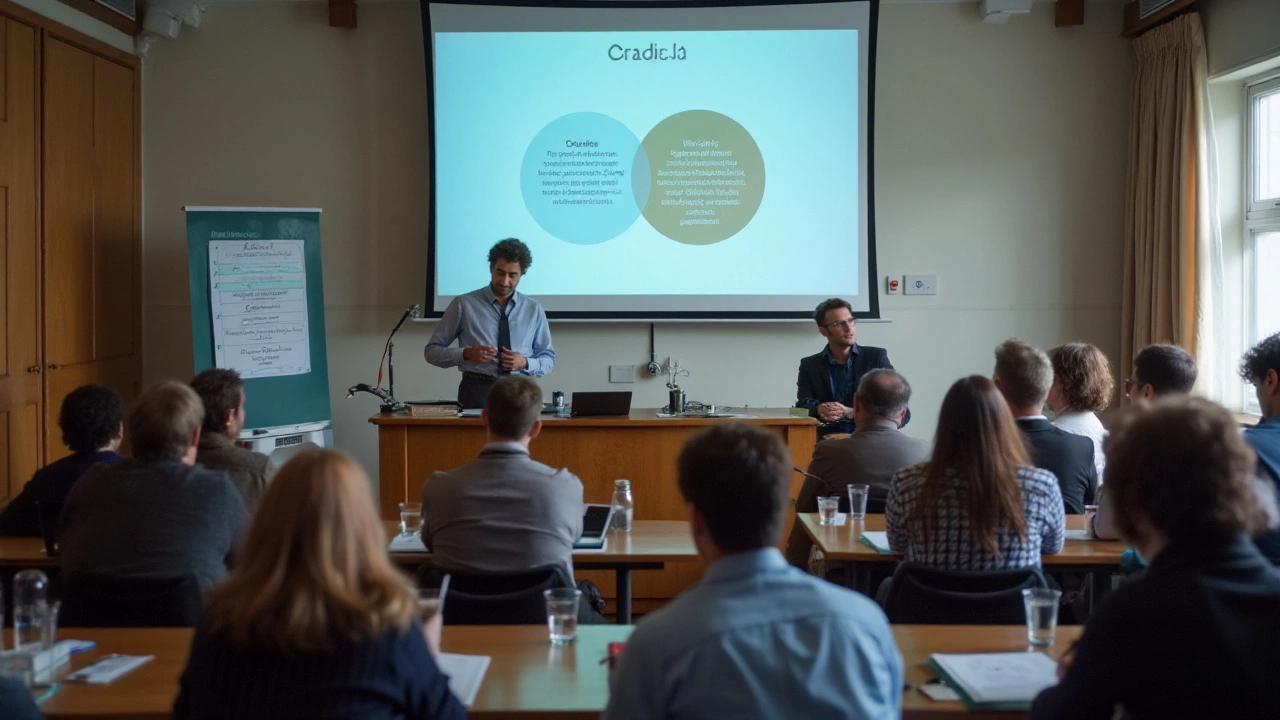When pondering the intricate world of neurodevelopmental disorders, ADHD and autism often come hand in hand. This connection is not surprising given the overlap in certain symptoms, such as challenges with social interactions and maintaining attention. However, lumping them together can lead to misconceptions. Unraveling the threads of these conditions reveals both shared patterns and stark differences.
Both ADHD and autism spectrum disorders are conditions that impact individual development and everyday life. Yet, they each have distinct characteristics rooted in different neurological paths. This means that understanding one doesn't necessarily equate to understanding the other in full.
Diving into the nuances can help us approach each condition with the sensitivity and insight it demands. It's not about fitting into a category but understanding the unique ways these conditions manifest and affect lives. Let's take a meaningful look at how ADHD and autism connect and diverge in the fascinating tapestry of human neurodiversity.
- Recognizing ADHD and Autism
- Common Traits and Differences
- The Science Behind ADHD and Autism
- Debunking Common Myths
- Implications in Daily Life
- Moving Forward with Understanding
Recognizing ADHD and Autism
Understanding how to distinguish between ADHD and autism can be like trying to navigate through a dense forest without a map. While both conditions are neurodevelopmental, meaning they affect brain development, each has its own unique set of traits yet can sometimes share overlapping symptoms. ADHD, or Attention-Deficit/Hyperactivity Disorder, is characterized by a persistent pattern of inattention and/or hyperactivity-impulsivity that interferes with functioning or development. You'll often find individuals with ADHD exhibiting signs like being easily distracted, having trouble organizing tasks, and impulsively interrupting conversations. Meanwhile, autism spectrum disorders manifest through challenges in social skills, repetitive behaviors, and in some cases, unique strengths like exceptional memory skills. It's not uncommon for people with autism to have an intense focus on specific topics or activities, were as those with ADHD might struggle to focus on any one thing for too long.
It's essential to note that these two conditions, while separate from each other, can co-occur. This makes diagnosis tricky. A study by the Centers for Disease Control and Prevention (CDC) indicates that about 30-50% of individuals diagnosed with autism also exhibit ADHD symptoms. What's fascinating is how the neurological underpinnings of each condition contribute to this overlap. Both conditions involve differences in brain structure and neurotransmitter activity, which may explain why they appear together. Yet, the genetic and environmental factors responsible for each disorder can be vastly different. Understanding these distinctions helps provide personalized support and interventions for those affected.
Recognizing and distinguishing these conditions takes patience, keen observation, and oftentimes, professional evaluation. Dr. Tony Attwood, a psychologist known for his work on autism, once said,
"Understanding requires not just knowledge, but empathy—recognizing the child's perspective is not wrong, just different."With this mindset, caregivers and educators can better support individuals by viewing behaviors through the lens of each condition. Assessments by trained professionals often include behavioral evaluations, psychological testing, and thorough questions about developmental history.
Another layer of consideration is how each condition impacts daily life differently. For a child with ADHD, classroom settings might be a labyrinth of distraction, requiring specific strategies to maintain focus. On the other hand, an autistic child might struggle with changes in routine or processing social cues, necessitating a more structured and predictable environment. Teachers and parents alike benefit from understanding these unique challenges and implementing tailored strategies to support learning and development. Small adjustments like breaking tasks into manageable steps or using visual schedules can make a significant difference.
Empathy, understanding, and knowledge are key components in recognizing and supporting individuals with ADHD and autism. Whether it's through adapting environments or employing specific interventions, the goal remains the same: to celebrate and harness individual strengths while accommodating and supporting challenges. As our understanding of autism spectrum disorders and ADHD continues to evolve, so too must our approaches to education and integration, enabling those with these conditions to lead fulfilling, successful lives.
Common Traits and Differences
Navigating the world of ADHD and autism can feel like deciphering an intricate map where certain lines run parallel, but ultimately take different directions. Both conditions fall under the umbrella of neurodevelopmental disorders, which means they affect how the brain and nervous system develop. While each person experiences these conditions uniquely, there are common touchpoints that tend to surface in general discussions. ADHD is primarily known for its triumvirate of symptoms: inattention, hyperactivity, and impulsivity. These can manifest as difficulty in sustaining attention, organizing tasks, or constant movement. Meanwhile, the spectrum of autism is marked by challenges in social communication and repetitive behaviors. These fundamental differences can shape daily interactions significantly. Neurodiversity, a term gaining traction, celebrates these variations as natural human differences rather than deficits. This perspective is vital in understanding the coexistence of traits in ADHD and autism.
Despite their differences, ADHD and autism sometimes share similar traits which leads to overlapping diagnoses. Both can involve struggles with social skills and an affinity for routine, creating a blend that's hard to unravel. For instance, both conditions can present challenges in understanding social cues. However, their roots often differ; ADHD might display as impulsiveness in social settings, whereas autism may result in a more conscious yet awkward approach. Moreover, sensory sensitivities can be present in both disorders, though the triggers or reactions might diverge significantly. "The world's leading researchers are still exploring the intricate connections between ADHD and autism, highlighting how complex these neurodevelopmental paths are," says Dr. Emily Simonoff, a respected voice in the field. This shared landscape is a reminder of the importance of tailored approaches in management, avoiding one-size-fits-all solutions.
"Although ADHD and autism are distinct disorders, their similar features can sometimes result in overlapping diagnoses. This highlights the need for nuanced understanding and personalized approaches in treatment," says Dr. Emily Simonoff.
Understanding these similarities and differences better equips educators, parents, and medical professionals to tailor support strategies. Knowing that many individuals might display traits of more than one condition can help frame more effective approaches to learning and social engagement. Structured environments can benefit both groups, though the methods can differ; those with autism spectrum disorders might thrive with visual schedules, while those with ADHD may require interactive tasks to maintain focus. Some data even suggests that up to 30% of individuals with autism also present symptoms of ADHD, fostering an ongoing inquiry into their interconnectedness. This overlap in characteristics frequently calls for a nuanced diagnosis process and personalized strategies to enhance day-to-day living.

The Science Behind ADHD and Autism
When it comes to the scientific exploration of ADHD and autism, the journey into the mind is as captivating as it is complex. Both conditions have intrigued researchers for decades, propelling extensive studies into their origins and manifestations. Autism spectrum disorders (ASD) are primarily associated with differences in brain structure and function, particularly affecting areas related to communication and behavior. Neuroimaging studies often show variations in cortical thickness and connectivity in individuals with autism, hinting at why social interactions might be challenging.
Conversely, ADHD is more focused on the brain's chemical transmission systems, such as dopamine pathways. Dopamine is fundamental in regulating attention and impulse control, which sheds light on why individuals with ADHD might struggle in these areas. Genetic factors play a significant role in both conditions; however, pinpointing exact genetic causes remains a puzzle. Researchers suggest that multiple genes contribute to each condition, and these can be influenced by environmental factors such as prenatal exposure to toxins, diet, and stress.
Dr. Brian King, a noted neurologist, once famously remarked,
"Understanding the roots of ADHD and autism requires an appreciation for the intricate dance of genetics and environment.”This perspective encourages a comprehensive view that includes hereditary tendencies and life experiences. Twin studies provide compelling evidence of a genetic link, revealing higher concordance rates in identical twins than in fraternal twins for both ADHD and autism.
Despite these insights, the overlap in symptoms between ADHD and autism poses a diagnostic challenge. Some current hypotheses suggest that structural brain changes, combined with neurotransmitter imbalances, could explain shared symptoms like difficulty focusing. However, recognizing the distinct pathways involved in each condition remains crucial for effective treatment and support. Recent advancements also indicate the influence of neurodiversity acceptance in shaping therapeutic approaches. This shift advocates for embracing different brain functions as variations, not deficiencies. As such, the scientific community continues to balance probing into the brain's underpinnings with fostering inclusive environments where individuals' unique strengths are celebrated.
Debunking Common Myths
In today's society, misunderstandings about ADHD and autism are unfortunately widespread, leading to stigma and barriers that affect many people's lives. It is vital to tackle these myths head-on and replace them with accurate, research-backed information. One common misconception is that both ADHD and autism stem from poor parenting or a lack of discipline. This assumption is not only incorrect but also unhelpful. Both conditions are neurodevelopmental disorders with genetic, neurological, and environmental components impacting the brain's structure and function. Shifting away from this myth helps destigmatize these conditions and encourages supportive, inclusive environments.
Another myth suggests that individuals with ADHD or autism lack creativity or are not intelligent, which couldn't be further from the truth. Many people with these conditions display remarkable creativity and problem-solving abilities. Consider the example of Temple Grandin, an influential autistic thinker who revolutionized practices in livestock handling industry. In her words, "I am different, not less," she highlights how embracing neurodiversity can lead to extraordinary achievements. The myth that these individuals cannot succeed in certain fields limits opportunities and fails to recognize the unique perceptions they bring to the world.
The belief that autism and ADHD always co-occur is another misconception needing correction. While they can present together in some individuals, it is not a rule. The conditions possess overlapping characteristics like social challenges and attention difficulties, but their diagnostic criteria differ significantly. It's important to approach each condition with its specific set of behaviors and symptoms to offer more precise support and intervention.
There's also the assertion that individuals with these conditions will "grow out of it," especially when it comes to ADHD. While some symptoms can change or lessen with age, the underlying neurological differences remain. Both ADHD and autism are lifelong conditions, and support systems are necessary at all life stages. Ignoring this fact can lead to gaps in care and support that are essential for promoting well-being.
To continue, the notion that medication should be the sole treatment avenue is another myth to debunk. While medications can be an effective part of treatment plans for conditions like ADHD, relying solely on them overlooks the importance of behavioral therapies, social skills training, and educational interventions. It’s about creating a comprehensive approach that addresses various aspects of an individual's needs and promotes the best outcomes.
In our quest for clarity, statistics reveal that understanding the nuances of these conditions is growing. Studies indicate that around 5% of children globally have ADHD, whereas autism affects about 1% of the population. Recognizing these numbers doesn't diminish the variability within each condition but rather highlights the necessity for personalized approaches. By addressing these myths, we move closer to creating more knowledgeable and inclusive communities where individuals with ADHD and autism can not only thrive but be celebrated for their distinctive contributions.

Implications in Daily Life
Living with either ADHD or autism presents distinct challenges and revelations that mold daily experiences in unique ways. Individuals with these conditions often see the world through a lens richly colored with nuances others might miss. This means simple tasks can become more intricate, demanding special techniques for effective management. For instance, routines, which can seem monotonous for most, often offer a comforting structure for those on the autism spectrum. This predictability can make a world of difference, transforming potentially chaotic environments into manageable worlds. On the other hand, those with ADHD might find routines stifling. Their need for dynamism and novelty means static daily life becomes a quest for the next interesting encounter or project, highlighting the importance of balance between the familiar and new.
Social Interactions and Communication
Social life with ADHD and autism entails navigating an unpredictable landscape. Social cues, often subtle and fleeting, might not register the same way for these individuals. This can make interactions challenging, resulting in misunderstandings or feelings of isolation. The shared struggles in socialization are instructive yet frustrating lessons in empathy and perception, affecting personal relationships and professional environments. Consider a classroom scenario where group work is required; the dynamics here can be overwhelming for students with these conditions. Ensuring clear, structured communication and opportunities to express oneself in a supportive setup becomes a vital educational tool. In such environments, both peers and teachers become allies, learning to appreciate diverse perspectives.
Educational and Work Environments
In schools and workplaces, adjusting to the needs of individuals with ADHD and autism isn’t just a recommendation; it's necessary for true inclusivity. It's common for students with ADHD to excel when subjects capture their attention, turning hyperfocus into an academic superpower. Likewise, workplaces that promote sensory-friendly environments can unlock the potential of autistic employees, whose attention to detail can be unmatched. Adaptations like flexible working hours or tailored job roles promote productivity and reduce stress.
As Susan Daniels, a leading autism researcher, notes, "Workplaces that champion neurodiversity see increases in creativity and employee engagement."This transparent support ensures that differences are celebrated as strengths, not barriers.
Behavioral Patterns and Adaptation
Transforming behaviors into lifesaving routines requires support, understanding, and practice. Coping mechanisms are as diverse as the individuals themselves; strategies that work wonders for one may fall flat for another. Parents of children with ADHD, for example, often document numerous trials before finding techniques that help manage attentiveness during homework sessions. Meanwhile, adults with autism might employ visualization exercises to anticipate social scenarios, relying on visual aids and lists to navigate through them. Consider integrating mindfulness exercises as part of these routines. Mindfulness can aid in mitigating stress and improving concentration, providing a mental anchor during turbulent moments. It’s not just about coexistence; it’s about thriving amidst the variety of stimuli and opportunities life presents.
Moving Forward with Understanding
The journey to better understanding ADHD and autism requires both compassion and a continual commitment to education. As society grows more aware of neurodiversity, it is imperative to shed light on both distinctions and intersections of these conditions. This awareness not only helps in reducing stigmatization but also enhances the quality of life for those directly affected. Every individual has a unique comprehension and experience with their worldview; thus, empathy and patience become critical tools in how we interact and support one another.
One crucial step is to advance educational initiatives. Increasing access to comprehensive resources will equip parents, teachers, and friends with the much-needed knowledge to recognize and nurture traits associated with ADHD and autism. By understanding how these traits manifest, we can encourage environments that support growth and acceptance. This might include adapting teaching methods to accommodate different learning styles or simply providing a little more time during tasks that require intense focus.
Moreover, scientific research continues to expand our understanding of how ADHD and autism intersect. It is an exciting arena where each study contributes to a broader mosaic of insights. According to the Centers for Disease Control and Prevention (CDC), in 2020, around 9.8% of children aged 3-17 years were reported as having ever been diagnosed with ADHD. Data like this underscores the reality of these conditions, helping to forge paths to practical solutions.
The famous psychologist, Dr. Temple Grandin, once said, "The world needs all kinds of minds." This reinforces the idea that diversity in thought and perception is indeed an asset.
Supporting Adaptive Strategies
Encouraging adaptive strategies is another way to move forward. This may include implementing technology aids, organizational tools, or even designing spaces that minimize overstimulation. Simple changes can lead to monumental improvements in day-to-day functioning, effectively eliminating barriers and promoting independence. These strategies can be tailored to fit individual needs—look at them as a customized toolkit for better living.
Engaging Community and Building Networks
On a community level, engaging in dialogue and network-building can help erase misconceptions. Support groups and forums offer platforms where shared experiences breed solidarity and innovation. It's here that peer support can make all the difference, providing real-life examples and advice that only someone who has been there can offer. Establishing a fabric of understanding across various facets of everyday life empowers those with ADHD and autism, letting them lead fulfilling lives without condescension or misunderstanding.
Finally, policymakers play a crucial role in shaping accessible resources and services. Advocacy is not just about raising awareness—it’s about pushing for laws and policies that prioritize mental health initiatives, inclusivity in the workforce, and tailored educational programs. The destigmatization of neurodevelopmental disorders benefits everyone, fostering a culture that celebrates different ways of thinking. It is this broader acceptance and integration that allows each individual to thrive to their maximum potential.





